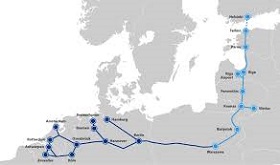Baltic, Construction, EU – Baltic States, Financial Services, Funds, Railways
International Internet Magazine. Baltic States news & analytics
Saturday, 20.04.2024, 13:58
ECA: Cost of Rail Baltic projected to increase by 51% compared to initial estimates
 Print version
Print version |
|---|
While according to the initial estimate, the construction of Rail Baltic would have cost around 4.65 bn euros, the latest estimate from the ECA is that the total cost of the project will be seven billion euros. Costs include the provisions for risks of future cost increases as identified by the auditors. The official costs are stated to be 5.8 bn euros so far.
An assessment of the passenger traffic part of the Rail Baltica line shows that it is not economically sustainable, with 4.6 mln passengers per year by 2030. According to the ECA, major transport infrastructures with a high-speed rail component need to serve 9 mln passengers a year to ensure sustainability.
"If we include the access line to Poland and perform a more general analysis, once the line up to Warsaw has been built and upgraded, the overall population living within the 60-minute catchment area will go up to 8.3 mln. If we compare this to our benchmark of 9 mln passengers per year, economic sustainability may be at risk even for the full connection up to Warsaw," it is said in the audit.
"In the case of Rail Baltic, recent reports by the national supreme audit institutions of the Baltic countries have already highlighted risks of implementation delays, which may negatively impact the entry into operation of the TFI. Latvia’s National Audit Office has highlighted risks of delays of between one and four years due to among other things, a late start and bureaucratic national procedures related to land expropriation," the audit said.
According to the ECA, only Rail Baltic and three parts of three other TFIs audited are likely to meet the minimum requirements of the TEN-T Regulation by 2030. The main reasons for these poor results are that the member states have their own priorities and different procedures, as well as different speeds of implementation, while cross-border TFIs are not always equally supported.
The ECA audited the involvement of the European Commission in the planning, implementation and monitoring of the co-financing of eight major infrastructures. These include Rail Baltic, a rail line connecting Estonia, Latvia and Lithuania to Poland and enabling a link to Finland; the Lyon-Turin link, a cross-border rail link connecting France and Italy; the Brenner Base Tunnel, a cross-border rail link connecting Austria and Italy; the Fehmarn Belt fixed link, a rail/road connection between Denmark and Germany; the Basque Y and its connection with France, a high-speed rail connection linking up Vitoria in Spain to Bordeaux in France; the Seine-Scheldt link, originally an inland waterway link between the rivers Seine and Scheldt, evolving into an inland waterway network in France and Belgium; the A1 motorway in Romania; the E59 railway line in Poland and its connection to the ports of Szczecin and Swinoujscie.
- 26.08.2021 LLC Dizozols Investments finalizes investment attraction deal with Crowdestor with record-high profits
- 25.01.2021 Как банкиры 90-х делили «золотую милю» в Юрмале
- 30.12.2020 Hotels showing strong interest in providing self-isolation service
- 30.12.2020 EU to buy additional 100 mln doses of coronavirus vaccine
- 30.12.2020 ЕС закупит 100 млн. дополнительных доз вакцины Biontech и Pfizer
- 29.12.2020 В Латвии вводят комендантский час, ЧС продлена до 7 февраля
- 29.12.2020 В Rietumu и в этот раз создали особые праздничные открытки и календари 2021
- 29.12.2020 Latvia to impose curfew, state of emergency to be extended until February 7
- 29.12.2020 Linde Gas открывает завод в Кедайняйской СЭЗ
- 29.12.2020 В Риге можно изолироваться в трех гостиницах








 «The Baltic Course» Is Sold and Stays in Business!
«The Baltic Course» Is Sold and Stays in Business!

